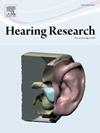基于数值模拟的上管BPPV Yacovino操作优化
IF 2.5
2区 医学
Q1 AUDIOLOGY & SPEECH-LANGUAGE PATHOLOGY
引用次数: 0
摘要
我们通过数值模拟评估了原始的Yacovino手法(YM)治疗上管良性阵发性位置性眩晕(SC-BPPV)的有效性,并提出了改进方案以提高其疗效。采用高分辨率三维显微计算机断层扫描(μCT)重建人体膜性迷路,模拟BPPV的情况。通过求解Navier-Stokes方程建立了内淋巴流体动力学模型,并将大小不等(3-30µm)的耳蜗作为拉格朗日粒子引入。他们的位移是用一种优越的以运河为中心的极坐标系来跟踪的。模拟了两种机动方案:原始YM和调整旋转角度和每步30秒休息间隔的改进版本。最初的YM导致耳蜗陷在壶腹和耳管切换,限制了其有效性。相比之下,改良后的ym——患者面朝下躺,头屈曲50°,然后优化后续旋转——显著改善了耳蜗向黄斑的迁移。更长的静止时间进一步增强了较小颗粒的位移而不影响机动安全。这些结果表明,改良的YM是一种安全有效的SC-BPPV治疗方案。根据解剖学的可变性来调整旋转角度可能会改善结果,但仍需要临床验证。本文章由计算机程序翻译,如有差异,请以英文原文为准。
Optimization of the Yacovino maneuver for superior canal BPPV using numerical simulations
We evaluated the effectiveness of the original Yacovino maneuver (YM) for treating superior canal benign paroxysmal positional vertigo (SC-BPPV) using numerical simulations and proposed modifications to enhance its efficacy. A high-resolution three-dimensional micro-computed tomography (μCT) reconstruction of a human membranous labyrinth was used to simulate the BPPV condition. Endolymphatic fluid dynamics were modeled by solving the Navier–Stokes equations, and otoconia of varying sizes (3–30 µm) were introduced as Lagrangian particles. Their displacement was tracked using a superior canal-centric polar coordinate system. Two maneuver protocols were simulated: the original YM and a modified version with adjusted rotational angles and a 30-second resting interval per step. The original YM resulted in otoconia trapping in the ampulla and canal switching, limiting its effectiveness. In contrast, the modified YM—in which the patient lies face down with a 50° head flexion in the initial step, followed by optimized subsequent rotations—significantly improved otoconia migration toward the utricular macula. Longer resting times further enhanced the displacement of smaller particles without compromising maneuver safety. These findings suggest that the modified YM is a safe and effective alternative for SC-BPPV treatment. Tailoring rotation angles based on anatomical variability may improve outcomes, though clinical validation is still required.
求助全文
通过发布文献求助,成功后即可免费获取论文全文。
去求助
来源期刊

Hearing Research
医学-耳鼻喉科学
CiteScore
5.30
自引率
14.30%
发文量
163
审稿时长
75 days
期刊介绍:
The aim of the journal is to provide a forum for papers concerned with basic peripheral and central auditory mechanisms. Emphasis is on experimental and clinical studies, but theoretical and methodological papers will also be considered. The journal publishes original research papers, review and mini- review articles, rapid communications, method/protocol and perspective articles.
Papers submitted should deal with auditory anatomy, physiology, psychophysics, imaging, modeling and behavioural studies in animals and humans, as well as hearing aids and cochlear implants. Papers dealing with the vestibular system are also considered for publication. Papers on comparative aspects of hearing and on effects of drugs and environmental contaminants on hearing function will also be considered. Clinical papers will be accepted when they contribute to the understanding of normal and pathological hearing functions.
 求助内容:
求助内容: 应助结果提醒方式:
应助结果提醒方式:


